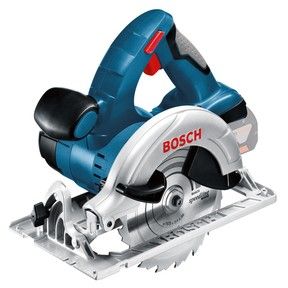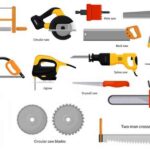Rather than simply duplicating various handheld saws, powered saws have evolved to fill niches of their own. For example, a radial arm saw expands on the capabilities of a miter saw and circular saw, but does not directly duplicate either. Powered saws come in three primary categories: Continuous Band, Reciprocating Blade, and Circular Blade.
 Band Saw (Stationary)
Band Saw (Stationary)
This tall, floor-standing saw uses large pulleys above and below the cutting table to move a continuous band with fine teeth to cut through most materials. Band saws are perfect for intricate cutting of curves into wood, as well as cutting tubes, piping, and PVC, but are limited to a depth of only a few inches.
Resawing (cutting boards so they are thinner) is possible with a band saw by standing the board on its edge and carefully ripping it using a fence. Patience is definitely required for this task.
 Band Saw (Portable)
Band Saw (Portable)
A small portable version of the stationary unit, it can accomplish most of the same jobs as its big brother with the portability to be able to take to a jobsite or someone else’s garage. You are of course more limited as to what you can cut (typically up to 3-4″ diameter pipes) and it takes more effort to make straight cuts, but it can be an invaluable tool especially for plumbers, welders, and metalworkers.
 Chain Saw
Chain Saw
As the name implies, a chainsaw uses a linked chain with numerous specially designed ripping teeth. While chainsaws are uniquely designed, they fall into the category of band saws. Chainsaws are more commonly used in tree work than any other field, and may be essential to homeowners depending on your region.
 Chop Saw
Chop Saw
One of the largest portable versions of circular saws, the chop saw is manufactured in both metal and masonry cutting versions. The concrete cutting saw often includes a connection for a water line to reduce dust while cutting.
Both types of chop saws use toothless blades manufactured with special abrasives designed for the materials to be cut. Chop saws are also known as cut-off saws, concrete saws, and abrasive saws.
 Circular Saw
Circular Saw
Sometimes referred to as a buzz saw or by the popular brand name of Skilsaw, circular saws use a toothed blade, typically between 7-¼ and 9 inches in diameter. They are the most common type of powered saw, and accept blades that cut all types of wood, metal, plastic, masonry, and more.
 Compound Miter Saw
Compound Miter Saw
This is the miter saw on steroids. Compound saws are used to make straight, miter, and compound cuts. Instead of pivoting up and down the way a miter saws cuts, the blade is mounted on an arm that can be adjusted for complex angles, including cuts for complex scrollwork and trim.
The compound miter saw is one of the best time-savers when you need to trim out windows or add crown molding.
 Flooring Saw
Flooring Saw
As the name implies, a flooring saw is a portable unit intended to re-saw flooring (hardwood, engineered, bamboo, or laminate) to fit. It’s a fairly specialized tool that in essence replaces a table saw, miter saw, and other accessories you may need to cut flooring.
The portability factor is its biggest advantage as you won’t have to spend a lot of time moving materials from garage to room and vice versa when putting in flooring.
 Jigsaw
Jigsaw
This handheld saw has a short, fine-toothed blade which moves up and down at variable speeds. This is one of the few saws which are designed specifically for cutting curves and other non-straight lines. Look for a jigsaw with a long cord or even a cordless option.
 Miter Saw
Miter Saw
One of the few saws designed to expressly mimic a hand saw, the miter saw is ideal for use in trim or other jobs involving precise measurements and angle cuts. A simple miter saw can pivot up to 45 degrees to either side of a straight 90 degree cut, and can be used in conjunction with tables for cutting long mitered ends.
 Radial Arm Saw
Radial Arm Saw
By placing the motor and blade on an arm that extends over the cutting table, the radial arm saw allows you to make identical compound cuts, miter cuts, and more. Depending on the manufacturer, radial arm saw blades may be interchangeable with circular saw blades, but verify the recommended speed of spin, as some radial saws turn very fast.
 Reciprocating Saw
Reciprocating Saw
Like the jigsaw, this saw has a blade which moves back and forth very quickly. Reciprocating saws are sometimes called a Sawzall®, referring to the original manufacturer of this type of saw. They are used for cutting tubing, wood, and plastics, and are also used for cutting beneath walls or wood joints because the blades can cut nails as well as wood. An invaluable tool for demolition work.
 Rotary Saw
Rotary Saw
Rotary saws (or rotary tools) have a fixed blade and a small screwdriver-type handle. They are used for everything from crafts to construction, and are ideal for cutting into a wall for access or repairs. Like the keyhole saw, a rotary saw is essential for drywall, panelling, and a myriad of other small cutting tasks.
 Scroll Saw
Scroll Saw
Scroll saws can operate with a band or a continuous or a reciprocating blade. Similar to coping saws, these powered saws are designed for intricate scroll work, spiral lines, or patterns with the added benefit of a table the material can be laid on while cutting to achieve precise rotation and detail. Creating curves with edges is what it excels at.
 Table Saw
Table Saw
Table saw blades tend to be a little larger than for a circular saw, and consist of a high speed motor mounted beneath a flat table. To adjust the the depth of cut, the blades rises out of the table bed. Table saws are great for making numerous rip cuts or preparing a large number of identical sized pieces.
Table saws accept metal and masonry blades, but take care that the blade design matches the motor rpm.


